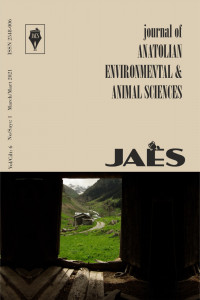Abstract
Recently, because of searching for alternative raw materials in the composite panels production; various materials and different types of wastes are widely evaluated. In this study, some mechanical and physical properties of fiberboard manufactured with beech wood fibers and waste carpet-flex were investigated. The panels were manufactured using urea formaldehyde (UF) and phenol formaldehyde (PF) adhesives. Waste carpet-flex was used as layer in the panel mat for the panel manufacturing. Modulus of rupture (MOR), modulus of elasticity (MOE), water absorption (WA) and thickness swelling (TS) values of these fiberboard panels were determined. As a result of study, it was found that the carpet-flex material and adhesive type affected the investigated properties of the fiberboard panels. The phenol formaldehyde and waste carpet flex usage improved the mechanical and physical properties of fiberboard
References
- Akgül, M. & Tozluoğlu A. (2008). Utilizing peanut husk (Arachis hypogaea L.) in the manufacture of medium-density fiberboards. Bioresource Technology, 99(13), 5590–5594.
- Akgül, M. & Çamlibel, O. (2008). Manufacture of medium density fiberboard (MDF) panels from rhododendron (R. ponticum L.) biomass. Building and Environment, 43 (4), 438–443.
- Atta-Obeng, E. (2011). Characterization of Phenol Formaldehyde Adhesive and Adhesive-Wood Particle Composites Reinforced with Microcrystalline Cellulose, M.S. thesis, Auburn University. https://etd.auburn.edu/bitstream/handle/10415/2694/thesis%20auburn.pdf?sequence=2&isAllowed=y
- EN 310 (1993). Wood Based Panels, Determination of Modulus of Elasticity in Bending and Bending Strength, European Committee for Standardization, Brussels, Belgium.
- EN 317 (1993). Particleboards and Fiberboards, Determination of Swelling in Thickness After Immersion, European Committee for Standardization, Brussels, Belgium.
- Jain, A., Pandey, G., Singh, A.K. & Rajagopalan V. (2012). Fabrication of Structural Composites from Waste Carpet, Advances in Polymer Technology, 31(4), 380–389.
- Karaduman, Y. & Onal, L. ( 2011). Water absorption behavior of carpet waste jute-reinforced polymer composites, Journal of Composite Materials, 45(15), 1559–1571.
- Kotliar, A. M. (1999). Woodlike Properties from Carpet and Textile Fibrous Waste: Mitigating the Coming Landfill Crisis, Polymer-Plastics Technology and Engineering, 38(3), 513-531, DOI: 10.1080/03602559909351597.
- Mishra, K., Das, S. & Vaidyanathan, R. (2019). The Use of Recycled Carpet in Low-Cost Composite Tooling Materials, Recycling, 4(12), doi:10.3390/recycling4010012.
- Nemli, G., Yıldız, S., &Gezer, E.D. (2008). The potential for using the needle litter of Scotch pine (Pinus sylvestris L.) as a raw material for particleboard manufacturing, Bioresource Technology, 99, (14), 6054-6058.
- Onal, L. & Karaduman, Y.(2009). Mechanical Characterization of Carpet Waste Natural Fiber-reinforced Polymer Composites, Journal of Composite Materials, 43(16), 1751-1768. Wang Y. (2010). Fiber and Textile Waste Utilization, Waste Biomass Valor 1, 135–143, DOI 10.1007/s12649-009-9005-y.
- Wang, Y., Zhang, Y., Polk, M., Kumar, S., &Muzzy J., (2003). Recycling of Carpet and Textile Fibers , Chapter 16, in Plastics and the Environment: A Handbook, Edited by Andrady A.L. (John Wiley & Sons, New York), pp.697-725. http://www.prism.gatech.edu/~yw6/Fiberrecycling/(intro)%20Fiber%20Recycling%20in%20Handbook%20-%20Chapter%2016.pdf.
- Zhang , Y., Muzzy J. D. & Kumar, S., (1999). Recycling Carpet Waste by Injection and Compression Molding, Polymer-Plastics Technology and Engineering, 38(3), 485-498, DOI: 10.1080/03602559909351595.
Abstract
Son dönemlerde, kompozit levha üretimlerinde alternatif hammadde arayışları ile birlikte birçok malzemenin ve farklı atık türlerinin yaygın olarak kullanım yeri bulduğu görülmektedir. Bu çalışmada, kayın odun lifleri ve halıfleks atıkları kullanılarak üretilen liflevhaların bazı mekanik ve fiziksel özellikleri araştırılmıştır. Deneme levhaları üre formaldehit(UF) ve fenol formaldehit(FF) tutkalları kullanılarak üretilmiş olup atık halıfleksler lif levha üretiminde levha taslağı içerisinde tabaka olarak kullanılmıştır. Üretilen levhaların eğilme direnci, eğilmede elastikiyet modülü, su alma ve kalınlığına şişme değerleri belirlenmiştir. Çalışma sonucunda, halıfleks kullanımı ve tutkal türünün levha gruplarının kalite özelliklerinde etkisinin olduğu, FF tutkalı ve halıfleks kullanımının levhaların mekanik ve fiziksel özelliklerini iyileştirdiği görülmüştür.
Keywords
References
- Akgül, M. & Tozluoğlu A. (2008). Utilizing peanut husk (Arachis hypogaea L.) in the manufacture of medium-density fiberboards. Bioresource Technology, 99(13), 5590–5594.
- Akgül, M. & Çamlibel, O. (2008). Manufacture of medium density fiberboard (MDF) panels from rhododendron (R. ponticum L.) biomass. Building and Environment, 43 (4), 438–443.
- Atta-Obeng, E. (2011). Characterization of Phenol Formaldehyde Adhesive and Adhesive-Wood Particle Composites Reinforced with Microcrystalline Cellulose, M.S. thesis, Auburn University. https://etd.auburn.edu/bitstream/handle/10415/2694/thesis%20auburn.pdf?sequence=2&isAllowed=y
- EN 310 (1993). Wood Based Panels, Determination of Modulus of Elasticity in Bending and Bending Strength, European Committee for Standardization, Brussels, Belgium.
- EN 317 (1993). Particleboards and Fiberboards, Determination of Swelling in Thickness After Immersion, European Committee for Standardization, Brussels, Belgium.
- Jain, A., Pandey, G., Singh, A.K. & Rajagopalan V. (2012). Fabrication of Structural Composites from Waste Carpet, Advances in Polymer Technology, 31(4), 380–389.
- Karaduman, Y. & Onal, L. ( 2011). Water absorption behavior of carpet waste jute-reinforced polymer composites, Journal of Composite Materials, 45(15), 1559–1571.
- Kotliar, A. M. (1999). Woodlike Properties from Carpet and Textile Fibrous Waste: Mitigating the Coming Landfill Crisis, Polymer-Plastics Technology and Engineering, 38(3), 513-531, DOI: 10.1080/03602559909351597.
- Mishra, K., Das, S. & Vaidyanathan, R. (2019). The Use of Recycled Carpet in Low-Cost Composite Tooling Materials, Recycling, 4(12), doi:10.3390/recycling4010012.
- Nemli, G., Yıldız, S., &Gezer, E.D. (2008). The potential for using the needle litter of Scotch pine (Pinus sylvestris L.) as a raw material for particleboard manufacturing, Bioresource Technology, 99, (14), 6054-6058.
- Onal, L. & Karaduman, Y.(2009). Mechanical Characterization of Carpet Waste Natural Fiber-reinforced Polymer Composites, Journal of Composite Materials, 43(16), 1751-1768. Wang Y. (2010). Fiber and Textile Waste Utilization, Waste Biomass Valor 1, 135–143, DOI 10.1007/s12649-009-9005-y.
- Wang, Y., Zhang, Y., Polk, M., Kumar, S., &Muzzy J., (2003). Recycling of Carpet and Textile Fibers , Chapter 16, in Plastics and the Environment: A Handbook, Edited by Andrady A.L. (John Wiley & Sons, New York), pp.697-725. http://www.prism.gatech.edu/~yw6/Fiberrecycling/(intro)%20Fiber%20Recycling%20in%20Handbook%20-%20Chapter%2016.pdf.
- Zhang , Y., Muzzy J. D. & Kumar, S., (1999). Recycling Carpet Waste by Injection and Compression Molding, Polymer-Plastics Technology and Engineering, 38(3), 485-498, DOI: 10.1080/03602559909351595.
Details
| Primary Language | Turkish |
|---|---|
| Journal Section | Articles |
| Authors | |
| Publication Date | March 31, 2022 |
| Submission Date | July 7, 2020 |
| Acceptance Date | November 30, 2021 |
| Published in Issue | Year 2022 Volume: 7 Issue: 1 |




